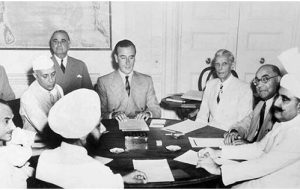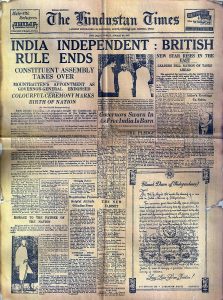14 The British Empire in India by Nick McFarlane
1. The major groups in India throughout the end of the British Raj

Lord Mountbatten meets Prime Minister to-be Jawaharlal Nehru and his council to begin negotiations for the Partition of India (1947) Unknown Author, Public Domain
| Curriculum context | VCE Unit 1 and 2: Empires Area of Study 2, Outcome 2 (VCAA, 2020) |
| Historical context | Exploring the influence of the British Empire throughout India before and after partition. |
| Historical thinking concepts | Construct historical arguments |
| Learning intention | Identify and examine the motivations of invested parties and groups involved in the removal of the British Raj, as well as the historical relevance of their tribulations with the British Empire. |
Activity
The year is 1947 and India has been occupied by the British Empire since 1858. After years of conflict and protest, the Crown rule in India is coming to an end. To better understand why, we need to understand which groups are the most motivated to see the British Empire stay or leave. Your task will be to research a particular group of people in India with your team, and report back to your table.
It is your task to ask the following questions:
- Describe your group – are there any key members?
- Summarise the history of your group and their history with India.
- How do they feel about the British Raj? Do they support the British operating in the government of India?
- Are there any events that affect your group that have made life better or worse?
- Does your group support independence? If they do, why? If they don’t, why not?
Answer these questions in long-form answers. You must provide evidence to support your claims. This may come in the form of newspapers, speeches, events, etc.
Students will form teams of four, which will become their ‘home base’, who they will report back to with their research. Students will be allocated a group of people to research from the table below. Once they have received their group, they will join students with the same group and this will become their ‘research team’, who will work together to gather research and create an understanding of the questions provided.
Groups:
- The British Raj
- Indian Soldiers
- Hindus
- Muslims
Once students have completed their research with their research teams, they will rejoin their home teams and share their information. A class discussion can follow this to further elaborate on the information found.
References
VCAA. (2020). VCE Study Design: History 2022-2026. Victorian Curriculum and Assessment Authority. https://www.vcaa.vic.edu.au/curriculum/vce/vce-study-designs/history/Pages/index.aspx
2 An independent India: Source analysis

Map of the partition of a now independent India 1947 (2017) by RaviC (CC BY-SA 4.0)
| Curriculum context | VCE Unit 1 and 2: Empires Area of Study 2, Outcome 2. |
| Historical context | Exploring the influence of the British Empire throughout India before and after partition. |
| Historical thinking concepts | Historical perspectives |
| Learning intention | Explain the impact of India’s independence, both geopolitically and locally within India.
Understand the sentiment towards the British Empire and contextualise that with the findings from the previous activity. Discuss the British Empire’s occupation of India and develop a historical understanding on the sentiment of India at this time. |
Activity
In a short window of time and amidst public pressure, Britain transitions India from colonial control to complete independence. As historians, we must explore the causes and effects of these circumstances, but also gather the collective insight from global communities to understand and engage with the state of the British Empire at this time. You will analyse the world’s response to the newly found independence of India and formation of Pakistan and Bangladesh, and answer the provided questions:
- Who wrote or published this source?
- Describe the medium used.
- How is India represented?
- Where could this source be found?
- What is the purpose of this source?
- How is the British Empire represented?
- How could this source motivate Europeans to feel about the British Empire?
- How could this source motivate non-Europeans to feel about the British Empire?
Source 1 – Excerpt from A Tryst with Destiny: Speech on the Granting of Indian Independence, August 14, 1947 made by Jawaharlal Nehru, the new Indian Prime Minister, Internet Modern History Sourcebook
“Long years ago we made a tryst with destiny, and now the time comes when we shall redeem our pledge, not wholly or in full measure, but very substantially. At the stroke of the midnight hour, when the world sleeps, India will awake to life and freedom. A moment comes, which comes but rarely in history, when we step out from the old to new, when an age ends, and when the soul of a nation, long suppressed, finds utterance…”
Source 2 – Newspaper from The Hindustan Times – 15 August, 1947 (CC0 1.0)

References
Roberts. S., Anderson. E., Chatterj. J. (2017) A tryst with destiny [Article]. University of Cambridge. https://www.cam.ac.uk/files/a-tryst-with-destiny/index.html
The Hindustan Times. (15 August 1947). The Hindustan Times front page 15 August 1947. Public Domain. https://commons.wikimedia.org/wiki/File:The_Hindustan_Times_front_page_15_August_1947_(1187_×_1600).jpg
VCAA. (2020). VCE Study Design: History 2022-2026. Victorian Curriculum and Assessment Authority. https://www.vcaa.vic.edu.au/curriculum/vce/vce-study-designs/history/Pages/index.aspx

